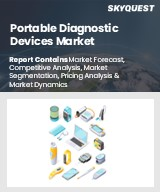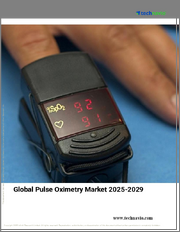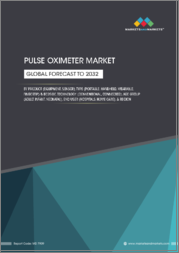
|
시장보고서
상품코드
1685225
경피적 산소농도 측정 시스템 시장 : 시장 기회, 성장 촉진요인, 산업 동향 분석, 예측(2025-2034년)Transcutaneous Oximetry Systems Market Opportunity, Growth Drivers, Industry Trend Analysis, and Forecast 2025 - 2034 |
||||||
세계의 경피적 산소농도 측정 시스템 시장은 2024년까지 2억 1,340만 달러에 이르렀고, 2025-2034년 연평균 복합 성장률(CAGR) 5.4%로 안정적인 성장률을 보일 것으로 예측됩니다.
이 시장 성장은 말초 동맥 질환 유병률 증가, 비침습적 모니터링 기술의 급속한 진보, 인구 고령화와 같은 복합 요인으로 인해 발생합니다. 효과적인 상처 케어의 필요성이 계속 증가하고 있는 가운데, 조직 내 산소농도를 모니터링하기 위해 경피적 산소농도 측정 시스템을 이용하는 의료 제공자가 증가하고 있습니다. 이 시스템은 적시에 정확한 판독을 가능하게 하며 조기 발견 및 예방 의료에 필수적입니다.

센서 기술과 무선 연결의 혁신은 이러한 시스템을 더욱 효율적으로 만들고 광범위한 헬스케어 환경에서 사용할 수 있습니다. 병원에서 외래 환자 시설에 이르기까지 경피적 산소농도 측정 시스템의 채용이 확대되고 있는 것은 정밀의료 및 환자 중심 케어를 향한 큰 동향을 반영하고 있습니다. 의료 제공업체가 진단 정확도를 높이고 워크플로우를 최적화하는 데 주력하는 동안 이러한 고급 모니터링 솔루션에 대한 투자가 증가하고 있습니다. 게다가 규제의 변화나 혈관 및 호흡기 질환에 대한 의식의 고조가 시장 역학의 형성에 기여하고 있습니다. 재택치료 및 원격 모니터링 솔루션에 대한 수요가 증가함에 따라 환자 및 간병인이 산소화 수준의 실시간 재택 모니터링을 요구하고 시장 성장을 더욱 촉진하고 있습니다.
| 시장 범위 | |
|---|---|
| 시작 연도 | 2024년 |
| 예측 연도 | 2025-2034년 |
| 시작 금액 | 2억 1,340만 달러 |
| 예측 금액 | 3억 5,550만 달러 |
| CAGR | 5.4% |
채널 유형별로 볼 때 시장은 멀티 채널 시스템과 싱글 채널 시스템으로 나뉩니다. 2024년에는 멀티 채널 시스템이 1억 5,650만 달러의 매출이 된 것으로 평가되었습니다. 복수의 부위에서 동시에 산소농도를 측정할 수 있기 때문에 진단 정밀도가 향상되고, 특히 복잡한 건강 상태의 환자에 대한 효율이 높아집니다. 여러 개별 측정이 필요 없기 때문에 이러한 시스템은 임상 워크플로우를 간소화하고 조직 산소화에 대한 종합적인 데이터를 제공하기 때문에 대량의 의료 시설에서 인기를 끌고 있습니다.
최종 용도별로는 병원이 2024년에 최대의 점유율을 차지해 시장을 리드했으며, 2034년에는 매출액이 1억 5,380만 달러에 이를 전망입니다. 병원에서는 말초 혈관 질환, 당뇨병, 호흡기 질환 등의 만성 질환 환자를 모니터링하기 위해 경피적 산소농도 측정 시스템의 채용이 증가하고 있습니다. 이러한 시스템은 조직의 산소화를 지속적이고 비침습적으로 평가하여 환자의 결과를 개선하는 시기 적절한 개입을 허용합니다. 상처 관리, 수술 후 모니터링, 혈관 평가 등 병원 전문 부문에서 이러한 장비의 통합이 진행됨에 따라 수요가 더욱 촉진되고 있습니다.
미국의 경피적 산소농도 측정 시스템 시장은 2024년에 9,700만 달러를 창출했으며, 2034년까지 CAGR 4.1%로 성장이 예측되고 있습니다. 미국은 의료기술 혁신의 세계적 리더로 지속되고 있으며, 다양한 헬스케어 분야에서 경피적 산소농도 측정 시스템이 널리 채용되는 원동력이 되고 있습니다. 센서의 정확성, 휴대성 및 무선 연결성 향상으로 이러한 시스템은 사용하기 쉽고 효율적입니다. 미국 의료 시스템이 예방 의료로 전환함에 따라 이러한 장비에 대한 수요는 크게 증가할 것으로 예상되어 지역 시장 확대에 기여하고 있습니다.
목차
제1장 조사 방법 및 조사 범위
제2장 주요 요약
제3장 업계 인사이트
- 생태계 분석
- 업계에 미치는 영향요인
- 성장 촉진요인
- 말초 혈관 장애 및 상처 치유 장애의 유병률 증가
- 진단 및 치료 중 환자 모니터링에 대한 관심 증가
- 기술의 진보
- 조산아에 대한 경피적 산소농도 측정 시스템의 사용에 관한 의식 증가
- 업계의 잠재적 위험 및 과제
- 엄격한 규제 정책
- 경피적 산소농도 측정 시스템과 관련된 높은 비용
- 성장 촉진요인
- 성장 가능성 분석
- 규제 상황
- 기술 상황
- 상환 시나리오
- 가격 분석
- Porter's Five Forces 분석
- PESTEL 분석
- 갭 분석
- 향후 시장 동향
- 밸류체인 분석
제4장 경쟁 구도
- 서문
- 기업 매트릭스 분석
- 기업 점유율 분석
- 주요 시장 기업의 경쟁 분석
- 경쟁 포지셔닝 매트릭스
- 전략 대시보드
제5장 시장 추계 및 예측 : 채널 유형별(2021-2034년)
- 주요 동향
- 멀티 채널
- 싱글 채널
제6장 시장 추계 및 예측 : 용도별(2021-2034년)
- 주요 동향
- 말초 혈관 장애
- 당뇨병성 발궤양
- 조산
- 기타 용도
제7장 시장 추계 및 예측 : 최종 용도별(2021-2034년)
- 주요 동향
- 병원
- 외래수술센터(ASC)
- 진단센터
- 기타 최종 사용자
제8장 시장 추계 및 예측 : 지역별(2021-2034년)
- 주요 동향
- 북미
- 미국
- 캐나다
- 유럽
- 독일
- 영국
- 프랑스
- 스페인
- 이탈리아
- 네덜란드
- 아시아태평양
- 중국
- 일본
- 인도
- 호주
- 한국
- 라틴아메리카
- 브라질
- 멕시코
- 아르헨티나
- 중동 및 아프리카
- 남아프리카
- 사우디아라비아
- 아랍에미리트(UAE)
제9장 기업 프로파일
- ADVIN
- Cephalon
- Drager
- ELCAT
- medicap
- PERIMED
- PHILIPS
- RADIOMETER
- sentec
The Global Transcutaneous Oximetry Systems Market reached USD 213.4 million by 2024 and is expected to exhibit a steady growth rate of 5.4% CAGR from 2025 to 2034. This market growth is driven by a combination of factors, including the increasing prevalence of peripheral artery disease, the rapid advancements in non-invasive monitoring technologies, and the aging population. As the need for effective wound care continues to rise, more healthcare providers are turning to transcutaneous oximetry systems to monitor oxygen levels in tissues. These systems allow for timely and accurate readings, essential for early detection and preventive care.
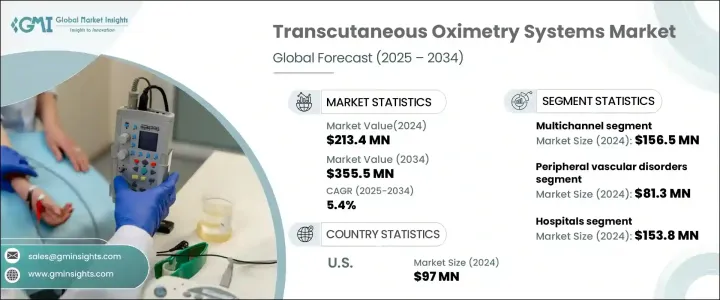
Innovations in sensor technology and wireless connectivity are making these systems more efficient and accessible across a wide range of healthcare settings. From hospitals to outpatient facilities, the growing adoption of transcutaneous oximetry systems reflects a larger trend toward precision medicine and patient-centered care. With healthcare providers focused on improving diagnostic accuracy and optimizing workflows, investments in these advanced monitoring solutions are increasing. Additionally, regulatory changes and growing awareness about vascular and respiratory conditions are helping to shape market dynamics. The rising demand for home healthcare and remote monitoring solutions further fuels the growth of the market, as patients and caregivers seek real-time, at-home monitoring of oxygenation levels.
| Market Scope | |
|---|---|
| Start Year | 2024 |
| Forecast Year | 2025-2034 |
| Start Value | $213.4 Million |
| Forecast Value | $355.5 Million |
| CAGR | 5.4% |
By channel type, the market is divided into multichannel and single-channel systems. In 2024, multichannel systems are projected to generate USD 156.5 million in revenue. Their ability to measure oxygen levels at multiple sites simultaneously boosts diagnostic accuracy and enhances efficiency, especially for patients with complex health conditions. By eliminating the need for multiple individual readings, these systems streamline clinical workflows and provide comprehensive data on tissue oxygenation, driving their popularity in high-volume healthcare facilities.
In terms of end use, hospitals lead the market with the largest share in 2024, with revenue expected to reach USD 153.8 million by 2034. Hospitals are increasingly adopting transcutaneous oximetry systems to monitor patients with chronic conditions such as peripheral vascular disease, diabetes, and respiratory disorders. These systems offer continuous, non-invasive assessments of tissue oxygenation, enabling timely interventions that improve patient outcomes. The growing integration of these devices in specialized hospital departments, such as wound management, post-surgical monitoring, and vascular assessments, is further fueling demand.
The U.S. transcutaneous oximetry systems market generated USD 97 million in 2024, with a projected CAGR of 4.1% through 2034. The U.S. remains a global leader in medical technology innovation, driving the widespread adoption of transcutaneous oximetry systems across various healthcare sectors. Improvements in sensor precision, portability, and wireless connectivity are making these systems more user-friendly and efficient. As the U.S. healthcare system shifts towards preventive care, the demand for these devices is expected to grow significantly, contributing to regional market expansion.
Table of Contents
Chapter 1 Methodology and Scope
- 1.1 Market scope and definitions
- 1.2 Research design
- 1.2.1 Research approach
- 1.2.2 Data collection methods
- 1.3 Base estimates and calculations
- 1.3.1 Base year calculation
- 1.3.2 Key trends for market estimation
- 1.4 Forecast model
- 1.5 Primary research and validation
- 1.5.1 Primary sources
- 1.5.2 Data mining sources
Chapter 2 Executive Summary
- 2.1 Industry 3600 synopsis
Chapter 3 Industry Insights
- 3.1 Industry ecosystem analysis
- 3.2 Industry impact forces
- 3.2.1 Growth drivers
- 3.2.1.1 Increasing prevalence of peripheral vascular disorders and wound healing disorders
- 3.2.1.2 Rising focus towards patient monitoring during diagnosis and treatment
- 3.2.1.3 Technological advancements
- 3.2.1.4 Growing awareness regarding use of transcutaneous oximetry systems for preterm infants
- 3.2.2 Industry pitfalls and challenges
- 3.2.2.1 Stringent regulatory policies
- 3.2.2.2 High cost associated with transcutaneous oximetry systems
- 3.2.1 Growth drivers
- 3.3 Growth potential analysis
- 3.4 Regulatory landscape
- 3.5 Technology landscape
- 3.6 Reimbursement scenario
- 3.7 Pricing analysis
- 3.8 Porter’s analysis
- 3.9 PESTEL analysis
- 3.10 Gap analysis
- 3.11 Future market trends
- 3.12 Value chain analysis
Chapter 4 Competitive Landscape, 2024
- 4.1 Introduction
- 4.2 Company matrix analysis
- 4.3 Company market share analysis
- 4.4 Competitive analysis of major market players
- 4.5 Competitive positioning matrix
- 4.6 Strategy dashboard
Chapter 5 Market Estimates and Forecast, By Channel Type, 2021 — 2034 ($ Mn)
- 5.1 Key trends
- 5.2 Multichannel
- 5.3 Single channel
Chapter 6 Market Estimates and Forecast, By Application, 2021 — 2034 ($ Mn)
- 6.1 Key trends
- 6.2 Peripheral vascular disorders
- 6.3 Diabetic foot ulcers
- 6.4 Preterm births
- 6.5 Other applications
Chapter 7 Market Estimates and Forecast, By End Use, 2021 — 2034 ($ Mn)
- 7.1 Key trends
- 7.2 Hospitals
- 7.3 Ambulatory surgical centers
- 7.4 Diagnostic centers
- 7.5 Other end users
Chapter 8 Market Estimates and Forecast, By Region, 2021 — 2034 ($ Mn)
- 8.1 Key trends
- 8.2 North America
- 8.2.1 U.S.
- 8.2.2 Canada
- 8.3 Europe
- 8.3.1 Germany
- 8.3.2 UK
- 8.3.3 France
- 8.3.4 Spain
- 8.3.5 Italy
- 8.3.6 Netherlands
- 8.4 Asia Pacific
- 8.4.1 China
- 8.4.2 Japan
- 8.4.3 India
- 8.4.4 Australia
- 8.4.5 South Korea
- 8.5 Latin America
- 8.5.1 Brazil
- 8.5.2 Mexico
- 8.5.3 Argentina
- 8.6 Middle East and Africa
- 8.6.1 South Africa
- 8.6.2 Saudi Arabia
- 8.6.3 UAE
Chapter 9 Company Profiles
- 9.1 ADVIN
- 9.2 Cephalon
- 9.3 Drager
- 9.4 ELCAT
- 9.5 medicap
- 9.6 PERIMED
- 9.7 PHILIPS
- 9.8 RADIOMETER
- 9.9 sentec







